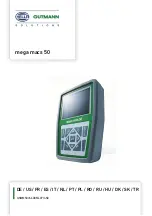
21
Remoción de las cuchillas
Afilado de las cuchillas
Regulado de la contracuchilla
MANUAL TÉCNICO DE OPERACIÓN - JF 15D
Para remover las cuchillas (A), basta retirar los tornillos (B), junto con las respectivas arandelas.
1- El afilado de la cuchilla debe ocurrir siempre que el corte estuviere gastado.
2- Debe ser hecha solo de un lado del corte de la cuchilla, procurándose mantener la misma
inclinación del corte original.
3- Se debe procurar retirar la misma cantidad de material en cada cuchilla, para no perjudicar
el balanceo.
4- Las cuchillas deberán ser substituidas cuando no posibilitaren más afilado.
Para regular la contracuchilla, proceder de la siguiente manera:
1- Soltar las tuercas de los dos tornillos (C).
2- Desplazar la contracuchilla (D) hasta que la distancia entre cuchilla y contracuchilla
(medida M de la figura abajo) sea de aproximadamente 0,5 mm.
3- Reajustar las tuercas (C).
Nota:
Se debe substituir la contracuchilla cuando estuviere gasta y reajustarla
periódicamente.
Español
10
Application
Actuation
Operation
JF Máquinas forage chopper can be used for dried products as well as for fresh products.
Thus, for such products as sugarcane, grasses, branches, roots, tubers and forages used for
daily animal feed, as well as for shredding dry products, as corn kemels, corn with the leaves
and cob, dried rice plants, corn stalks, dried cereals, cereal straw, and others, used for
preparing animal feed and foods.
Using this machine for products, such as soybeans and rice, will wear out the components
prematurely, due to their abrasive nature. So, for this reason, if the user using the machine for
such products then the user will lose the guarantee and then, the user will be liable for the
results.
The JF 15D can be driven by motors (electric, diesel or gasoline) and by tractors. The
accessories for coupling include the stands, pulleys and belts and are supplied when ordered
by the customer.
DRY PRODUCTS:
The product, such as grains or cereals, is placed in the
intake chute or in the hopper, and drains into the blades,
which crack them and them it flows inside of the
machine, where it is hit by the hammers. Then it is
filtered through the sieve.
The granulation of the product depends on the sieve
used. This product can leave the machine through a
cyclone or just by draining into the lower outlet.
FRESH PRODUCTS:
The product is placed in the intake chute and drained
until it comes to the blades, which are responsible for
cutting it. The product can come out from the lower
chute as well as the upper outlet.
Summary of Contents for 15D
Page 2: ......











































